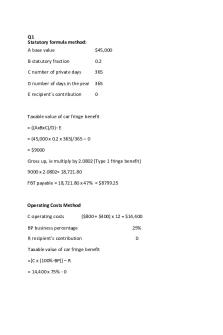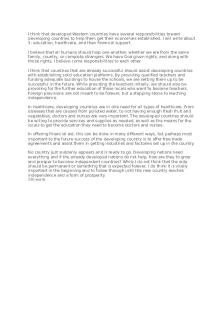Tut wk 8 calculation outline PDF

| Title | Tut wk 8 calculation outline |
|---|---|
| Author | Pill AndSoap |
| Course | Taxation Law |
| Institution | University of Technology Sydney |
| Pages | 4 |
| File Size | 129.3 KB |
| File Type | |
| Total Downloads | 32 |
| Total Views | 142 |
Summary
Download Tut wk 8 calculation outline PDF
Description
Q1 Statutory formula method: A base value
$45,000
B statutory fraction
0.2
C number of private days
365
D number of days in the year
365
E recipient’s contribution
0
Taxable value of car fringe benefit = ((AxBxC)/D)- E = (45,000 x 0.2 x 365)/365 – 0 = $9000 Gross up, ie multiply by 2.0802 (Type 1 fringe benefit) 9000 x 2.0802= 18,721.80 FBT payable = 18,721.80 x 47% = $8799.25
Operating Costs Method C operating costs
($800 + $400) x 12 = $14,400
BP business percentage R recipient’s contribution Taxable value of car fringe benefit =[C x (100%-BP)] – R = 14,400 x 75% - 0
25% 0
= $10,800 Gross up, ie multiply by 2.0802 (Type 1 fringe benefit) 10,800 x 2.0802= 22,466.16 FBT payable = 22,466.16 x 47% = $10,559.10
a) How (if at all) would your answer be different if the car travelled 10,000 km on business, out of the 30,000 km travelled during the year? This question illustrates the effect of an increase in the business use percentage. It only impacts the calculation under the operating costs method (see below) FBT payable under the statutory formula method is the same, so FBT payable is still lower under the statutory formula method.
Operating Costs Method C operating costs
($800 + $400) x 12 = $14,400
BP business percentage R recipient’s contribution
= 10,000/30,000 x 100 = 33.33%
0
Taxable value of car fringe benefit =[C x (100%-BP)] – R = 14,400 x 66.67% - 0 = $9,600.48 Gross up, ie multiply by 2.0802 (Type 1 fringe benefit) 9,600.48 x 2.0802= 19,970.92 FBT payable = 19,970.92 x 47% = $9386.33
b) If John made personal contributions for the car, what impact would this have on the taxable value of the car fringe benefit? Under either method, John’s personal contributions would reduce the taxable value of the car fringe benefit (see formulae), and generally reduce FBT payable.
Question 2 Advise Susie regarding the income tax implications arising in relation to the above facts. No deductions can be claimed for the four weeks Susie used the property herself as a holiday home. Susie can claim the full amount as a deduction for the agent’s commission (800) and costs of advertising for tenants (150). travel expenses re inspection of property are not deductible here under s26-31
Susie can claim deductions for her other expenses based on the proportion of the income year the property was rented out or was genuinely available for rent. Susie’s rental income and deductions for the year are as follows: Rent received $16,000 Rental deductions ((48/52 × $22,871) + $950) =22,061.69 Rental loss ($6,061.69) Susie can claim a rental loss of ($6,061.69) in her tax return. Susie needs to keep records of her expenses. If she later sells the property, the proportion of the expenses that she could not claim a deduction for may be taken into account in working out the capital gain.
Q3 Advise Xinyi regarding the income tax implications arising in relation to the above facts. No deductions can be claimed for the four weeks Xinyi used the property herself. She can claim the agent’s commission $800 and cost of advertising $200 as deductions. She can claim deductions for her other expenses based on the proportion of the income year it was rented out or was genuinely available for rent at the market rate: 45/52 weeks × $20,800 = $18,000. Because the rent Xinyi received from Sarah was less than market rate and her expenses were more than the rent received during that period, she cannot claim all of the expenses. Xinyi can only claim deductions equal to the amount of the rent during this period, that is, $600. (Note: if Sarah had rented the property for the market rate, Xinyi would have been able to claim deductions for the three week period of $1200 (3/52 × $20,800 = $1200)). Xinyi’s rental income and deductions for the year are as follows: Rent received $10,000 Rental deductions ($18,000 + $800 +200 + $600) $19,600 Rental loss ($9,600) Xinyi can claim a rental loss of $9,600 in her tax return. Xinyi needs to keep records of her expenses. If she later sells the property, the proportion of the expenses she could not claim a deduction for are taken into account in working out the capital gain....
Similar Free PDFs

Tut wk 8 calculation outline
- 4 Pages

TUT activities WK 8. pdf
- 2 Pages

Week 8 Tut Qs.......
- 1 Pages

Week 8 Tut Answers.
- 3 Pages

Administrative Law Wk 1 outline
- 6 Pages

TUT 4 - TUT 4
- 2 Pages

Finance Tut 2 - Tut 2
- 1 Pages

Tut Topic 8 QA-new - good
- 11 Pages

Discussion forum wk 8 bus 2207
- 1 Pages

Listening Quiz 2 (wk 5-8)
- 1 Pages

Sätze - Tut
- 1 Pages
Popular Institutions
- Tinajero National High School - Annex
- Politeknik Caltex Riau
- Yokohama City University
- SGT University
- University of Al-Qadisiyah
- Divine Word College of Vigan
- Techniek College Rotterdam
- Universidade de Santiago
- Universiti Teknologi MARA Cawangan Johor Kampus Pasir Gudang
- Poltekkes Kemenkes Yogyakarta
- Baguio City National High School
- Colegio san marcos
- preparatoria uno
- Centro de Bachillerato Tecnológico Industrial y de Servicios No. 107
- Dalian Maritime University
- Quang Trung Secondary School
- Colegio Tecnológico en Informática
- Corporación Regional de Educación Superior
- Grupo CEDVA
- Dar Al Uloom University
- Centro de Estudios Preuniversitarios de la Universidad Nacional de Ingeniería
- 上智大学
- Aakash International School, Nuna Majara
- San Felipe Neri Catholic School
- Kang Chiao International School - New Taipei City
- Misamis Occidental National High School
- Institución Educativa Escuela Normal Juan Ladrilleros
- Kolehiyo ng Pantukan
- Batanes State College
- Instituto Continental
- Sekolah Menengah Kejuruan Kesehatan Kaltara (Tarakan)
- Colegio de La Inmaculada Concepcion - Cebu




